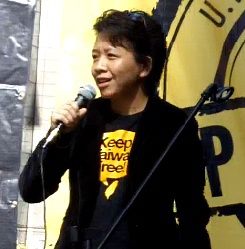
Welcome to FAPA-MA
The Formosan Association for Public Affairs, Massachusetts chapter (FAPA-MA) is based in Boston. We work closely with HQ to promote our messages locally in the greater Boston area and Massachusetts.
We have four main goals:
- Maintain active interactions with the local offices of MA congressmen/women and Senators, to discuss and update the offices with the latest political and cultural development in Taiwan.
- To bridge different Taiwanese communities in Boston/MA (first generation, second generation, and oversea students), hold events to bring the communities together to discuss issues related to Taiwan and US-Taiwan relations.
- Actively reach out to other local student, academic and grassroots activist groups.
- Monthly Keep Taiwan Free Harvard Square outreach to promote the spirit of Taiwan to the public.
About FAPA
Established in 1982 in Los Angeles, the Formosan Association for Public Affairs (FAPA) is a world-wide, Washington headquartered, non-profit organization that is set up:
- To promote international support for the right of the people of Taiwan to establish an independent and democratic country and to join the international community;
- To promote relations and cooperation between Taiwan and the United States;
- To protect the right of self-determination for the people of Taiwan;
- To promote peace and security for Taiwan; and
- To advance the rights and interests of Taiwanese communities throughout the world.
FAPA's mission is educational. The organization provides US policy makers, the media, scholars and the general public with information on issues related to Taiwan. FAPA informs and updates Members of Congress and their staff on Taiwanese issues. FAPA seeks to articulate the point of view of the people of Taiwan.
Click to read more about FAPA
About Taiwan
The size of Taiwan is approximately that of Delaware and Maryland combined. Taiwan is not only a land steeped in culture and history, but also a member of the world’s economic elite and a bastion of democracy in Asia. Its vibrant population of 23 million produces an annual GDP of over $320 billion, making it the world’s 18th largest economy. Taiwan is the 8th largest trading partner of the United States, and a strong ally, sharing with the United States the ideals of freedom, democracy, and self-determination.
Early History
Prior to 1600, Taiwan was solely inhabited by aborigines of Malay-Polynesian descent. In the early 1600s, it was settled by different European powers, including the Dutch (1624-1662, primarily around Tainan in the South) and the Spanish (1626-1642, around Keelung and Tamsui in the North). For the next two hundred years, the island was engulfed in civil unrest and constant rebellion until 1895 when it became a Japanese colony. The Japanese surrender at the end of World War II left Taiwan under the temporary administrative control of the Chinese Nationalists under Chiang Kai-Shek. When the KMT lost the Chinese civil war to the Communists in 1949, the KMT fled to Taiwan. From 1949 to 1987, the KMT kept Taiwan under martial law. Its economic policies led to rapid industrialization and growth.
From De-recognition to Today
Though a founding member of the United Nations in 1945, Taiwan lost its seat to the People’s Republic of China (PRC) in 1971. That precipitated Taiwan’s diplomatic de-recognition by the global community, culminating in the US’s normalization of relations with the PRC in December 1978. In April 1979, the US enacted into law the Taiwan Relations Act to safeguard Taiwan’s security and to signal continued US support of Taiwan, despite the absence of diplomatic relations. While enduring significant political isolation internationally, winds of change also swept Taiwan domestically. Martial law was finally lifted in 1987. Although restrictions continued, this signaled the liberalization of Taiwan’s political system. In 1996, Lee Teng-hui became the nation’s first democratically elected president. When former president Chen Shui-bian was elected in 2000, a peaceful transfer of power took place between the KMT and the Democratic Progressive Party (DPP). In March 2008, the KMT was voted back into power.
Relations across the Taiwan Strait
The status quo in the Taiwan Strait is one where Taiwan enjoys de facto independence as a free and democratic nation - although Taiwan remains under an ominous shadow cast by 1600+ Chinese missiles. The PRC continues to refuse to renounce the use of force against Taiwan, and claims Taiwan as a “renegade province.”
The US maintains and ambiguous “One-China” policy, which is a Cold War relic. There is a growing cry in Taiwan to abolish it to better fit the situation in the Taiwan Strait. Countless polls in Taiwan reflect the people’s rejection of unification with the PRC. Ultimately, the future of Taiwan must be decided by the Taiwanese themselves under the principle of self-determination as enshrined in the UN charter.
A change of the political landscape
In March and April 2014, a student movement titled the Sunflower Revolution changed the political landscape when they occupied the legislature in protest against the Service Trade Agreement with China, and the KMT government’s drift to China at the expense of Taiwan’s hard-won freedom and democracy.
This was followed in November 2014 by a landslide victory for the DPP in local elections. On January 16, 2016, Taiwan held presidential and legislative elections, in which the DPP’s Dr. Tsai Ing-wen won the presidency, and the DPP won a working majority in the Legislative Yuan.



